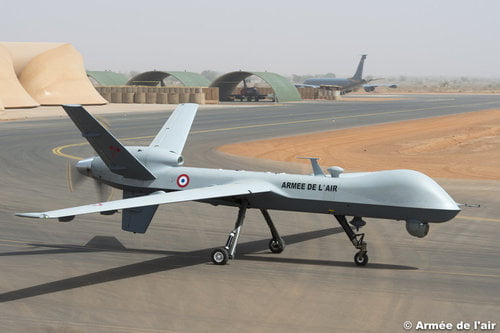2016-03-05 According to a story on the French Ministry of Defense website, the combination of Reapers and Harfangs have exceeded 15,000 operational hours during the Operation Barkhane.
The RPA squadron Belfort deployed in early 2013, and now has flown more than 15,000 hours with its RPAs.
The French Squadron operates two Harfangs and three MQ-9 Reapers.
The aircraft were first used in the Mali operation (Serval) and then in the renamed and refocused operation Barkhane that was launched on 1 August 2014.
There have been more than a thousand missions to support intelligence operations by the RPAs.
These aircraft are used to support the armed forces of partner countries in their fight against the armed terrorist groups in the region and to prevent the reconstitution of terrorist sanctuaries in the region.
According to Airbus Defence and Space, their Harfang RPA is described as follows:
Harfang is a Medium Altitude Long Endurance UAS for joint armed forces. It can fulfil a wide range of missions, from surveillance to sensitive peacekeeping.
Harfang provides real-time information at each level of the operational chain. It can be controlled either manually from the ground control station or autonomously.
Harfang is equipped with a SATCOM datalink and can operate with a 250 kg payload for more than 24 hours at a time.
Key characteristics:
Wingspan: 16.60m
Length: 9.30m
Height: 2.30m
Max altitude (ASL) : 25,000 ft (feet)
Max speed: 110 ktas (true airspeed in knots).
And an article in National Interest provided an overview on Operation Barkhane:
Operation Barkhane began on August 1, 2014 and took over the precedent French mission in Mali, Operation Serval.
Operation Barkhane, “named after a crescent-shaped dune in the Sahara desert,” is to become the French pillar of counterterrorism in the Sahel region.
The French will use and deploy a 3,000-strong counterterrorism force over five countries: Burkina Faso, Chad, Mali, Mauritania and Niger, also known as the ‘G5 Sahel.’
The purpose of Operation Barkhane is to “regionalize” the counterterrorism efforts in the Sahel, as well as bolster “cross-border and region-wide securitization efforts.”
According to the Ministry of Defense of France, Barkhane’s objectives are two-fold:
first, assist the G5 Sahel armed forces in fighting terrorist networks in the Sahel-Sahara region;
second, contribute to the prevention of terrorist safe-havens in the region.
In order to fight jihadists in this vast region, Operation Barkhane shall be seen as a reorganization of the forces already present in the region.




